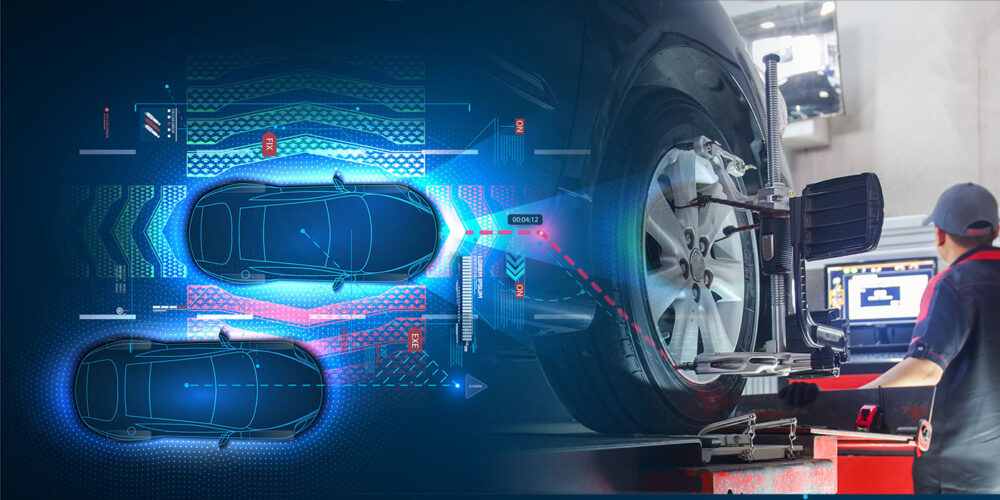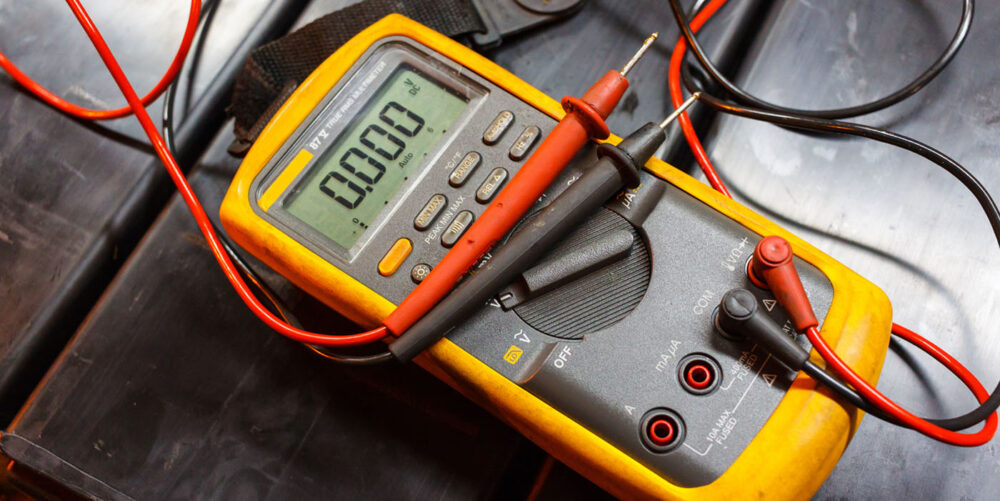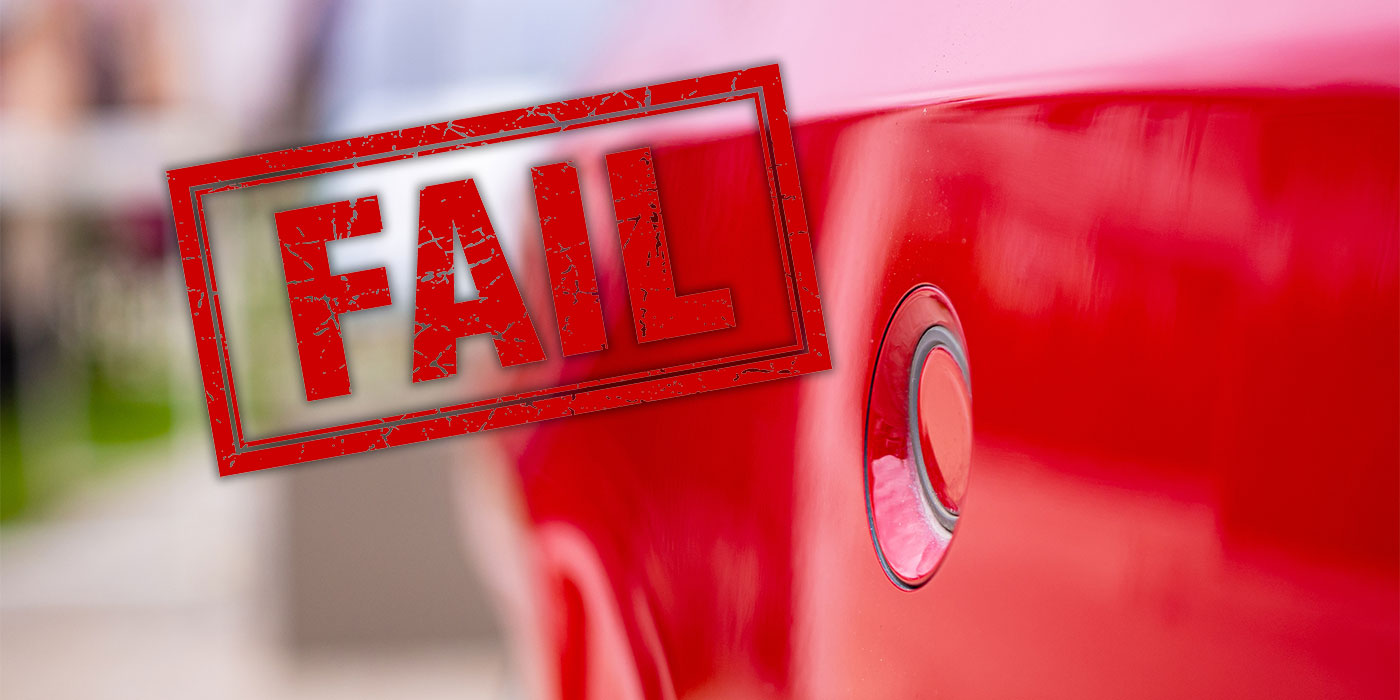As you drive down the road today, think about or watch how many everyday driving events can change a vehicle’s alignment. Collisions are just one of the causes of alignment issues on vehicles on U.S. roadways. Whether it’s potholes in your cities and highways or slipping and sliding in weather-related situations caused by snow and ice, vehicles are taking a lot of abuse as they speed down the road.
Tire wear and tear is not the only result of a vehicle out of alignment. Today’s electronic features that provide safety and assist drivers in daily driving rely on the alignment to function correctly. Many of you may have heard the phrase, “Garbage in equals garbage out,” as it relates to computers. This was commonly used to describe how incorrect data entered into a computer would give an incorrect response. As vehicles today evolve from cars to computers on wheels, this phrase is more and more becoming the starting point to diagnosing where problems are occurring on the vehicle. “Why is the system not working correctly?” actually comes down to, “Where is the incorrect data or lack of data coming from?”
Input Information
Collision damage, such as suspension damage or structural damage requiring pulling or replacement of parts, will call for an alignment to be performed. But collision damage may not be why the alignment is needed for a calibration to be performed. The phrase, “The crash damage was not enough to need an alignment,” may be incorrect according to some service procedures, because the calibration requires that all the input information is correct. This includes the vehicle correctly steering down the road.
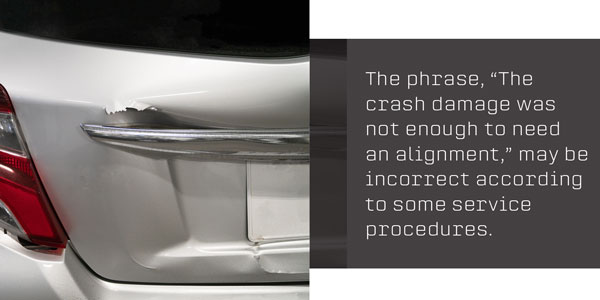
With all the damage a vehicle incurs driving on roadways, it’s understandable that before doing many calibrations for sensors — particularly relating to advanced driver-assistance systems (ADAS) — an alignment is needed. Performing a calibration on a vehicle that is not in alignment is not only completing the repair incorrectly but creating a dangerous situation for a family. The same can be said for a shop performing alignments and not doing a calibration after the alignment of the vehicle has been changed. The vehicle manufacturer service information will tell you if caster, camber or toe will require calibration. One input that must correctly supply information to the vehicle is the steering wheel angle sensor. If this input is garbage or incorrect due to misalignment, the lane departure and emergency braking — as well as other systems, such as rear camera alignment for backing up and self-parking features — will all be affected by the bad information.
The other side is parts that are simply worn out. We’ve all seen ball joints and tie rod ends that have come to the end of their lives. Replacing them and performing an alignment will possibly create the need for a calibration. This reason alone would create the need to complete an alignment before a calibration is attempted or completed. Whether it’s covered or is unrelated prior damage is between the shop and the customer. The shop may have to take the time to educate the customer on the importance of the alignment.
OEM Repair Information
Repair information changes constantly. What may have been correct six months ago may be wrong today, even between the same vehicle manufacturer year, make and model of vehicles. When researching and reading through the current service information, it’s critical to know if an alignment will call for a calibration or if a calibration will require an alignment to be performed. It is also important to know tolerances and specifications if the vehicle owner has modified the vehicle from OE specs. Lift kits, lowering packages, wheels and tires all affect sensor inputs for the vehicle. These modifications may not be listed in the service information. Also, the modifications may place the vehicle out of tolerance. One thing is for sure: You should not move the target to make the calibration work.
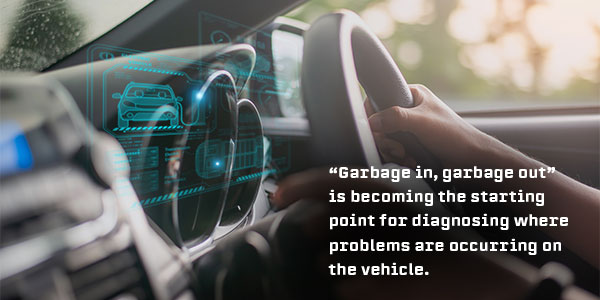
What’s interesting to me is the auto glass industry and windshield replacements. Where are the verification or alignment specifications for these repairs? It’s interesting when a company replaces a windshield and does a pre-scan and a diagnostic trouble code (DTC) comes up for the steering wheel angle sensor. What should happen to correct the issue for the calibration? If the calibration calls for an alignment, are these procedures being followed? In many cases with pre-scans, the vehicle may be out of alignment, but no DTC is shown on the pre-scan report. I realize this creates confusion in the industry, since many times, repair professionals will call out why different segments of the repair industry don’t follow the service information. Maybe it’s because nobody has truly looked at the service information and what it is saying needs to be done. The cost of the repair goes up dramatically, and many consumers don’t want or don’t have the ability to pay those costs. This is a discussion all of us in the industry need to have, as releasing a vehicle that is not performing to OE specifications is not the correct way to protect the family in that vehicle. Public education is something that must be promoted as an industry, because all that liability will fall onto the shop performing the repairs. No matter which way you look at the repair of newer vehicles, the more complex the vehicle, the higher the cost of repair.
New Equipment
We all see new equipment being introduced to the repair industry every day — so much, in fact, that it’s difficult to know which equipment to purchase to stay in the game, much less get ahead of it.
The basics required are the ability to do the alignment on the model of vehicle you’re working on, then the ability to do the calibration or calibrations if multiple ones are needed. If you sublet either or both operations, it saves on space in your shop and relieves you of the burden of training technicians and keeping up with alignments and calibrations. However, the time it takes to transport the vehicle off-site and scheduling would be a challenge for any repair facility using this process, especially considering more and more of these procedures need to be done on today’s vehicles. There are other complications too, such as knowing which calibrations need to be performed or whether a bumper cover removal will be necessary to do sensor alignments (part of many radar calibrations).
“Garbage in, garbage out” is becoming the starting point for diagnosing where problems are occurring on the vehicle.
Those who are performing services in-house also face challenges, such as keeping up with alignment equipment and training and also ADAS calibration equipment and vehicle requirements as well as what calibrations should be performed and what the shop thinks should be done. It’s a huge task to service multiple lines of vehicles. If you’re a dealer, you’re working on one line and doing very repetitive work. Facilities providing alignments and calibrations for the industry have to accommodate and be prepared for all vehicle lines. Hunter and Autel, in addition to other companies, are offering more and more equipment that is capable of doing calibrations on alignment racks to ensure their accuracy. This capability and the increasing number of vehicles needing this combination of repairs have made almost all shops think so hard about how to handle these procedures that, “When will shops need to bring alignments and calibrations in-house?” becomes the question.
Customer Complaints
Recent news about customers being unhappy with their vehicles’ ADAS performance after repairs made me look at the causes of these complaints. A large focus was the auto glass industry, but collision had their fair share too. I started to think of all the explanations I’ve given so far in this article and wondered how many times a calibration was performed on a vehicle with an alignment issue. I’m willing to bet that explanations such as, “The damage was not severe enough,” or, “It was not covered due to ‘recommend or require’ verbiage in a service procedure,” or, “The customer would not pay for the added cost,” was used to justify not doing an alignment.
I would love to hear from shops how many times the alignment was causing the performance issue for the complaint. I would also like to know how many warranties were due to not doing an alignment. Somewhere, that information is out there and would be interesting to see. On a side note: With this many dissatisfied customers, I would like to know who took the vehicle out for a drive to validate that all systems were working correctly and gave the vehicle to the customer.
Summary
Whether you’re a body shop, mechanical shop or insurance company, customer satisfaction is a critical piece to your company’s livelihood. People who have experienced a less-than-favorable repair from a shop will more than likely not use that shop again. Even for insurance companies, unsatisfactory experiences from recommended shops can look poorly on them and possibly affect policyholder retention. The reality is that the recommended shop could be affecting the decision on which insurance companies policyholders will use when renewing their policies or buying another policy for their families. No matter who you are, social media has a direct impact on your company and those you’re associated with.
When the vehicle leaves the shop, the expectation is that all systems will be correctly functioning, and this is done by correctly following all the car manufacturer’s procedures and recommendations to complete the repair process and validate all operations of the vehicle systems. It’s not just the repairs that have to be qualified as correct, but all the inputs must be verified that they’re functioning as required. This makes verifying that the alignment is correct important in the repair process. Unless you have so many customers and work that this is not an issue, it is something to think about.

